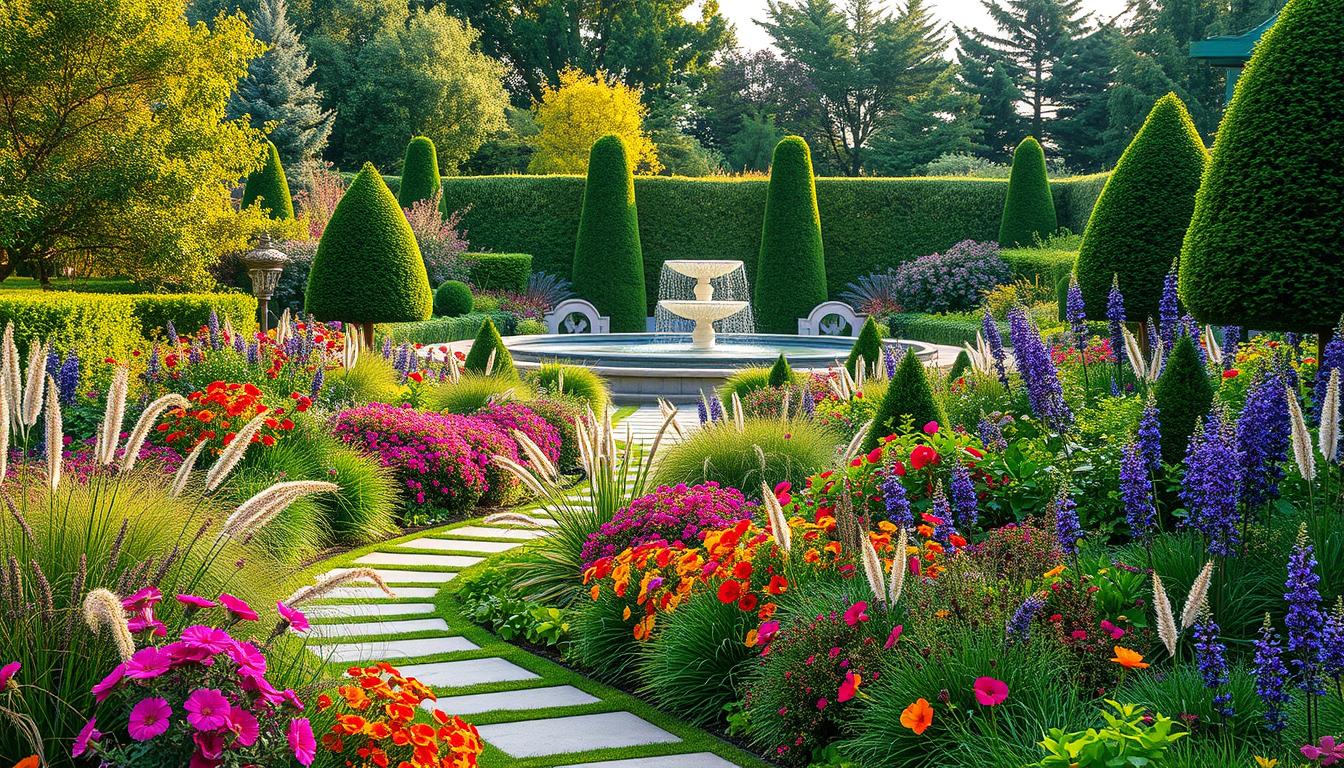Creating a beautiful outdoor space is more than just planting flowers. It’s about blending style and functionality to reflect your personality. Whether you have a small patio or a sprawling backyard, there are endless ways to transform your yard into a stunning retreat.
From vertical gardening to eco-friendly solutions, these 17 curated ideas cater to every space and climate. Inspired by global trends, these concepts are perfect for both beginners and seasoned professionals. You’ll find practical tips to make your outdoor area a true extension of your home.
No matter your skill level, these ideas will help you create a design that’s both beautiful and functional. Let’s explore how you can elevate your yard’s style and make it a place you’ll love spending time in.
Key Takeaways
- Personalized outdoor spaces blend aesthetics and functionality.
- Ideas cater to various yard sizes and regional climates.
- Includes vertical gardening and eco-friendly solutions.
- Inspired by global garden trends.
- Perfect for both beginners and professionals.
Introduction to Designer Garden Ideas
Modern outdoor spaces are evolving to reflect personal tastes and lifestyles. A well-thought-out design combines beauty and practicality, creating a space that’s both inviting and functional. Whether you’re working with a small patio or a large backyard, the right ideas can transform your area into a stunning retreat.
One of the latest trends is sensory gardens, which focus on engaging all five senses. These spaces often include fragrant flowers, textured foliage, and soothing water features. Another popular approach is foliage-focused designs, where plants with striking leaves take center stage. These trends highlight the importance of thoughtful planning and creativity.
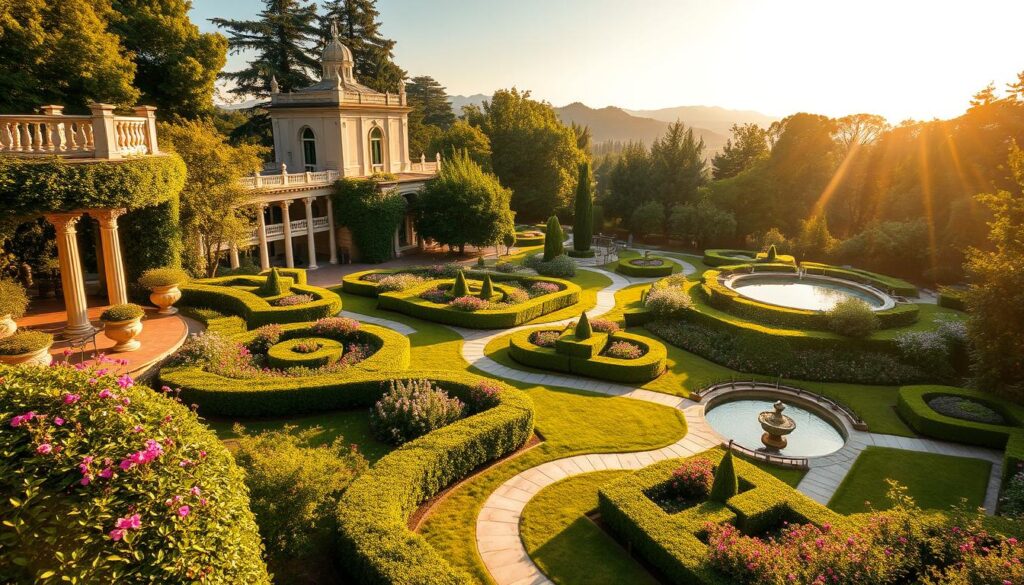
When planning your outdoor area, consider your local climate and maintenance needs. Native plants are gaining popularity for their adaptability and eco-friendliness. They require less water and care, making them a sustainable choice for any style of garden.
Another innovative concept is creating garden “rooms.” These are distinct areas within your yard, each serving a different purpose. For example, you might have a cozy seating area, a vibrant flower bed, and a tranquil water feature. This approach adds depth and variety to your outdoor design.
| Trend | Key Features | Benefits |
|---|---|---|
| Sensory Gardens | Fragrant flowers, textured foliage, water features | Engages all five senses, promotes relaxation |
| Foliage-Focused Designs | Plants with striking leaves, minimal flowers | Low maintenance, year-round appeal |
| Native Plant Integration | Local species, drought-tolerant plants | Eco-friendly, reduces water usage |
| Garden “Rooms” | Distinct areas for different purposes | Adds variety, maximizes functionality |
By incorporating these ideas, you can create an outdoor space that’s not only beautiful but also tailored to your lifestyle. Whether you’re a beginner or an experienced gardener, these concepts offer endless possibilities for elevating your yard’s style.
Maximizing Small Spaces with Creative Garden Designs
Small spaces can still shine with the right creative touch. Whether you’re working with a tiny balcony or a compact backyard, there are plenty of ways to make the most of your area. By focusing on smart design and innovative solutions, you can create a lush, functional retreat.
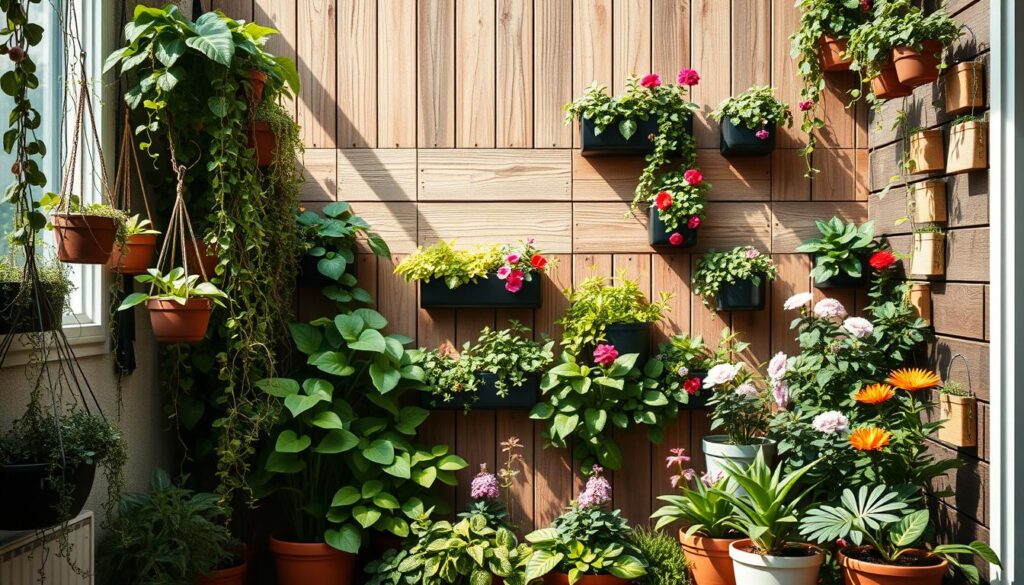
Vertical Gardens for Urban Spaces
One of the best ways to maximize limited space is by going vertical. Vertical gardens not only save room but also add a unique aesthetic to your area. Trellis systems, for example, are perfect for growing climbing plants like cucumbers and beans. They can save up to 40% of your ground space while improving air circulation.
Other space-saving solutions include herb walls and hanging planters. These options are ideal for urban dwellers who want to grow fresh herbs or flowers without taking up valuable floor space. Plus, they add a touch of greenery to even the smallest areas.
Compact Raised Beds for Limited Areas
If you’re working with a small yard, consider using compact raised beds. These systems are perfect for growing vegetables, herbs, or flowers in a confined space. Modular raised beds with built-in irrigation are especially convenient, as they reduce maintenance and ensure your plants stay healthy.
For those who love fresh produce, compact fruit varieties like patio tomatoes and dwarf citrus are excellent choices. They thrive in small containers or raised beds, making them perfect for urban settings. With the right design, even the tiniest areas can yield a bountiful harvest.
By incorporating these creative solutions, you can transform any small space into a vibrant, functional retreat. Whether you’re a beginner or an experienced gardener, these ideas will help you make the most of your area.
Front Yard Landscaping Ideas for Curb Appeal
Your front yard is the first impression of your home, so make it count. A well-designed landscape not only boosts your home’s appeal but also creates a welcoming atmosphere. Whether you’re starting from scratch or updating an existing design, these ideas will help you achieve a stunning look.
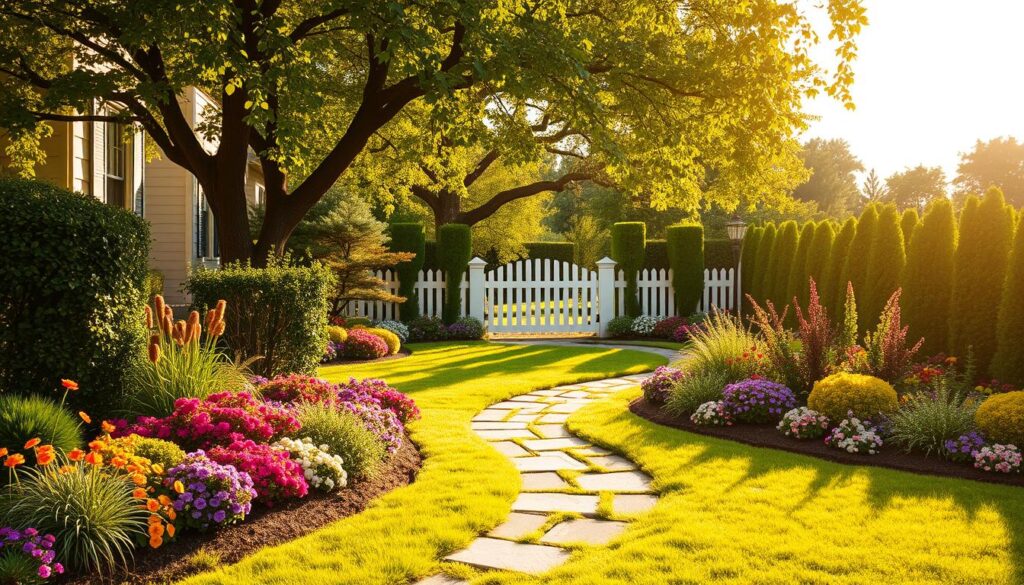
Choosing the Right Plants for Your Front Yard
Selecting the right plants is key to creating a cohesive and attractive front yard. Layered planting with evergreen shrubs provides structure and year-round interest. Textured shrubs, like those suggested in the Bark-Appeal Garden Plan, add depth and winter charm.
For a low-maintenance option, consider deer-resistant varieties. These plants not only deter wildlife but also thrive in various climates. Pair them with flowering perennials for seasonal color and visual interest.
Incorporating Pathways and Lighting
Pathways and lighting are essential elements of a functional and stylish landscape. Durable materials like bluestone pavers with creeping thyme create a timeless look. These pathways are both practical and visually appealing.
Low-voltage LED lighting techniques can highlight key features of your front yard, such as trees or flower beds. This not only enhances safety but also adds a warm, inviting glow to your outdoor space.
| Feature | Recommendation | Benefits |
|---|---|---|
| Plants | Evergreen shrubs, deer-resistant varieties | Year-round interest, low maintenance |
| Pathways | Bluestone pavers with creeping thyme | Durable, visually appealing |
| Lighting | Low-voltage LED lights | Enhances safety, adds ambiance |
Don’t forget small details like a mailbox garden. Climbing roses or clematis can transform a simple mailbox into a charming focal point. These finishing touches add personality and complete your front yard’s appeal.
Backyard Garden Ideas for Relaxation and Entertainment
Transform your backyard into a haven of relaxation and entertainment with these creative ideas. Whether you’re looking to unwind after a long day or host memorable gatherings, your outdoor space can be both functional and inviting. Let’s explore how to make the most of your area with thoughtful design and practical features.
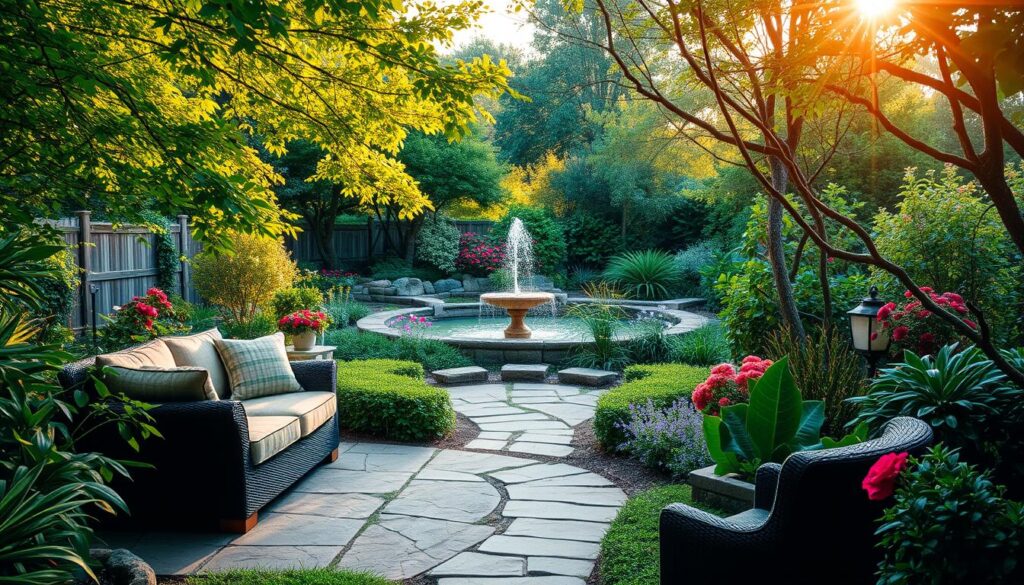
Creating a Cozy Outdoor Living Area
Start by designing a comfortable seating area. Multi-level decks with integrated planters are a great way to maximize space while adding greenery. Built-in seating with storage planters not only saves room but also keeps your tools and supplies close at hand.
For warmth and ambiance, consider adding a fire pit. Ensure proper safety clearances and choose heat-tolerant plant varieties like lavender or ornamental grasses. These plants thrive in high temperatures and add texture to your outdoor space.
Adding Water Features for Ambiance
Water features can elevate your backyard’s atmosphere. A whiskey barrel water garden is a compact solution that fits perfectly in smaller areas. It’s easy to maintain and adds a soothing element to your patio.
For urban settings, sound-masking waterfalls are an excellent choice. They reduce noise pollution while creating a tranquil environment. Pair these with an outdoor kitchen herb garden for a functional and stylish touch. Place herbs like basil and rosemary near your cooking area for easy access.
By incorporating these ideas, you can create a backyard that’s perfect for both relaxation and entertainment. Whether you’re enjoying a quiet evening or hosting friends, your outdoor space will be a true retreat.
Designing a Shade Garden for Cool Retreats
Transform shaded areas into lush, cool retreats with thoughtful planning. A shade garden offers a serene escape from the summer heat, combining beauty and functionality. Whether you have a small corner or a large wooded space, these tips will help you create a tranquil oasis.
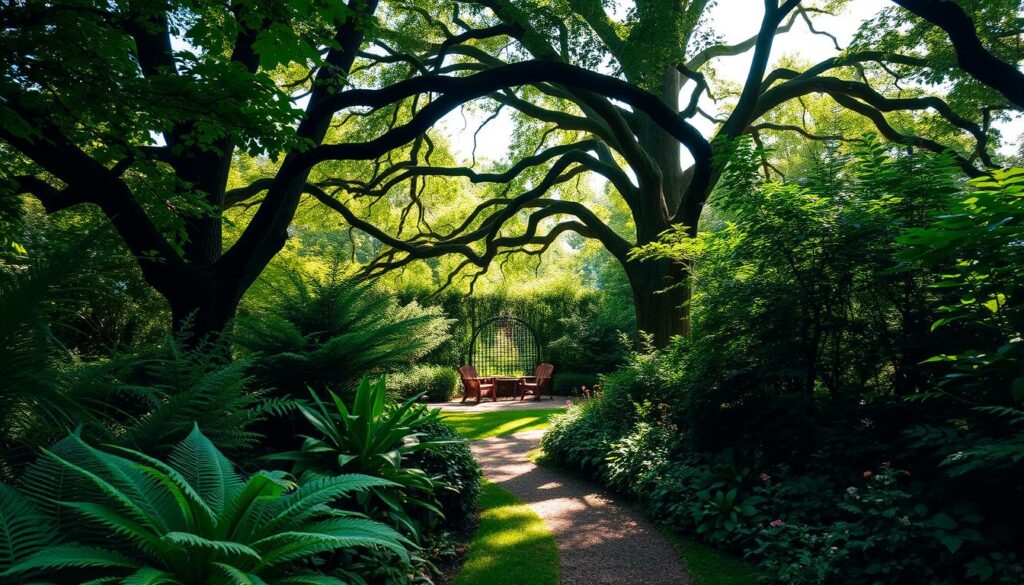
Selecting Shade-Tolerant Plants
Choosing the right plants is key to a thriving garden bed. Brunnera and hellebores are excellent alternatives to hostas, offering unique foliage and blooms. Japanese forest grass and coral bells add texture contrast, making your space visually dynamic.
For winter interest, consider planting winter flowers like hellebores or snowdrops. These plants thrive in shaded areas and provide year-round beauty. Pair them with light-reflecting mulch to brighten dark corners and enhance the ground’s natural appeal.
Using Hardscaping to Enhance Shady Areas
Hardscaping can elevate your shade garden’s design. Moss gardens between stepping stones add a soft, natural texture to the ground. This low-maintenance feature creates a serene atmosphere while blending seamlessly with the surroundings.
Pergolas with adjustable louvers are another great addition. They allow you to control light levels, ensuring your plants receive the right amount of shade. For more inspiration on outdoor decor, check out these boho yard decor ideas.
| Feature | Recommendation | Benefits |
|---|---|---|
| Plants | Brunnera, hellebores, Japanese forest grass | Thrive in shade, add texture and color |
| Mulch | Light-reflecting mulch | Brightens dark corners, enhances ground appeal |
| Hardscaping | Moss gardens, pergolas | Adds texture, controls light levels |
By incorporating these ideas, you can turn any shaded area into a stunning, functional retreat. Whether you’re looking for a peaceful escape or a vibrant space, a shade garden offers endless possibilities.
Eco-Friendly Garden Ideas for Sustainable Living
Sustainable living starts with eco-friendly choices in your outdoor space. By adopting green practices, you can create a yard that’s both beautiful and beneficial to the environment. From conserving water to supporting local wildlife, these ideas will help you make a positive impact.
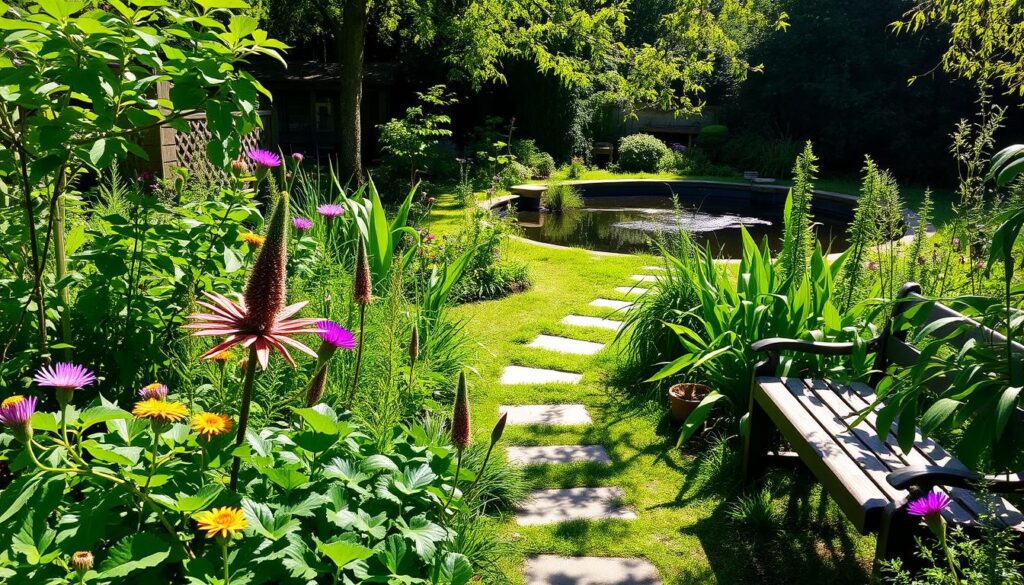
Planting Native Species for Wildlife Support
Native plants are a cornerstone of eco-friendly landscaping. They’re adapted to your local climate, requiring less water and maintenance. Plus, they provide food and shelter for pollinators like bees and butterflies. Consider adding wildflowers, shrubs, and grasses that thrive in your region.
Creating layered habitats is another great way to support wildlife. Meadow garden principles suggest mixing tall grasses, flowering perennials, and ground covers. This approach mimics natural ecosystems, offering diverse resources for birds, insects, and small mammals.
Rain Gardens for Water Conservation
Rain gardens are a smart solution for managing water runoff. These shallow, planted depressions capture rainwater, reducing erosion and filtering pollutants. A well-designed rain garden can cut runoff by up to 30%, while also supporting pollinators with native blooms.
For DIY enthusiasts, installing a rain barrel is another eco-friendly option. It collects rainwater from your roof, which you can use to irrigate your plants. To prevent mosquitoes, add a fine mesh screen and empty the barrel regularly.
Other sustainable practices include xeriscaping for arid regions and replacing traditional lawns with clover or micro-clover. These alternatives are drought-tolerant, low-maintenance, and eco-conscious. By incorporating these ideas, you can create a yard that’s both green and gorgeous.
Flower Garden Ideas for Year-Round Color
Bring vibrant life to your outdoor space with a flower garden that blooms all year. By carefully selecting plants and planning their placement, you can enjoy a continuous display of color in every season. Whether you’re aiming for a cutting garden or a decorative garden bed, these tips will help you create a stunning floral retreat.
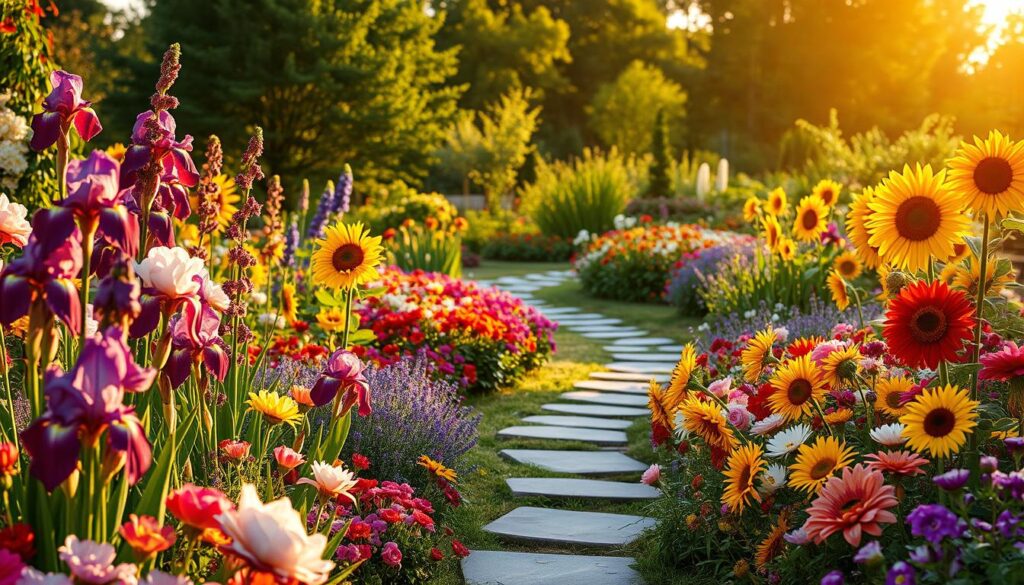
Seasonal Planting for Continuous Blooms
To ensure your garden stays lively throughout the year, focus on bloom sequence planning. Bulb layering techniques are a great way to achieve this. Plant early bloomers like crocuses and daffodils, followed by summer favorites such as zinnias and dahlias. Finish with fall bloomers like asters for a seamless transition.
For added durability, consider deer-resistant bulbs like alliums. These not only deter wildlife but also add unique shapes and textures to your garden bed. Pair them with perennials like lisianthus for a long-lasting display.
Designing a Cutting Garden for Fresh Bouquets
A cutting garden is perfect for those who love fresh flowers indoors. Use the “thriller-filler-spiller” method for container arrangements. Start with a bold centerpiece like a dahlia, add filler flowers such as zinnias, and finish with trailing plants like sweet potato vine.
Don’t forget to include drying flowers like statice and celosia. These can be preserved for winter arrangements, extending the joy of your garden into the colder months. As one gardener noted,
“Dried flowers bring a touch of summer warmth to winter days.”
Finally, apply color theory to your design. Use complementary hues for a striking contrast or monochromatic tones for a soothing effect. By combining these strategies, you can create a flower garden that’s both beautiful and functional.
Vegetable Garden Ideas for Homegrown Produce
Growing your own food is a rewarding way to connect with nature. A well-planned vegetable garden not only provides fresh produce but also enhances your outdoor space. Whether you’re a beginner or an experienced gardener, these tips will help you create a thriving kitchen garden.
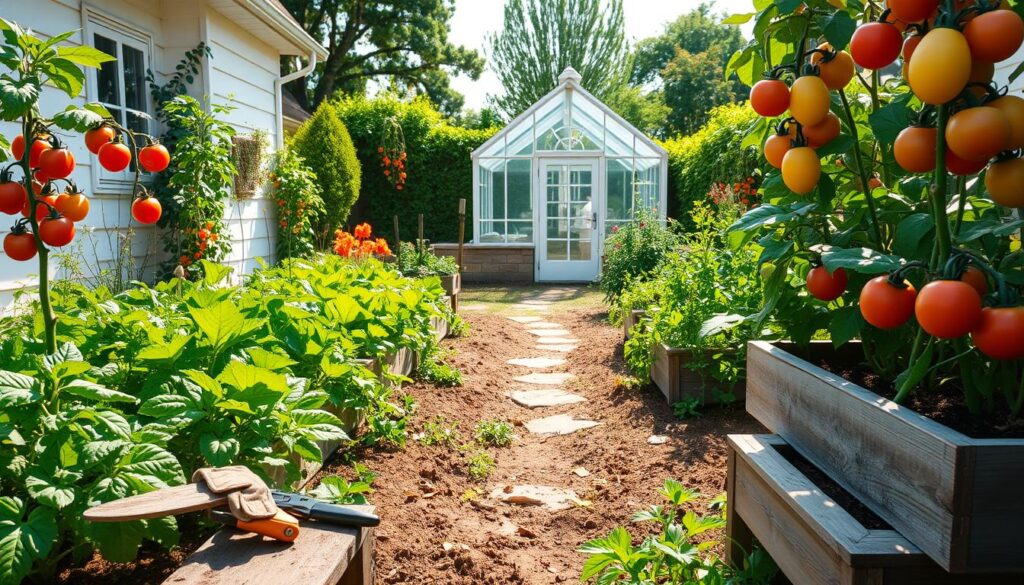
Planning a Kitchen Garden for Fresh Herbs and Veggies
Start by choosing a sunny spot for your kitchen garden. Companion planting, like pairing tomatoes with basil, maximizes space and boosts plant health. Succession planting ensures a continuous harvest. For example, plant lettuce in early spring, followed by beans in summer.
Include pest-deterrent flowers like marigolds and nasturtiums. These not only add color but also protect your plants from unwanted insects. As one gardener noted,
“Marigolds are nature’s pest control, keeping my veggies safe and healthy.”
Raised Beds for Easy Access and Maintenance
Raised beds are a game-changer for home gardeners. Ergonomic heights of 18-24 inches reduce strain and make gardening accessible for everyone. A 4’x8′ bed is ideal for growing a variety of herbs and vegetables.
Vertical supports, like trellises, are perfect for tomatoes and cucumbers. They save space and improve air circulation. For root cellar storage, consider crops like carrots and beets. These hardy vegetables last through winter, providing fresh produce year-round.
By combining these ideas, you can create a vegetable garden that’s both productive and enjoyable. Fresh flavors and sustainability are just steps away!
Container Garden Ideas for Small-Space Solutions
Container gardening offers endless possibilities for small spaces. Whether you have a tiny patio or a compact balcony, you can create a lush, vibrant retreat with the right container setup. From edible arrangements to decorative displays, these ideas will help you make the most of your space.
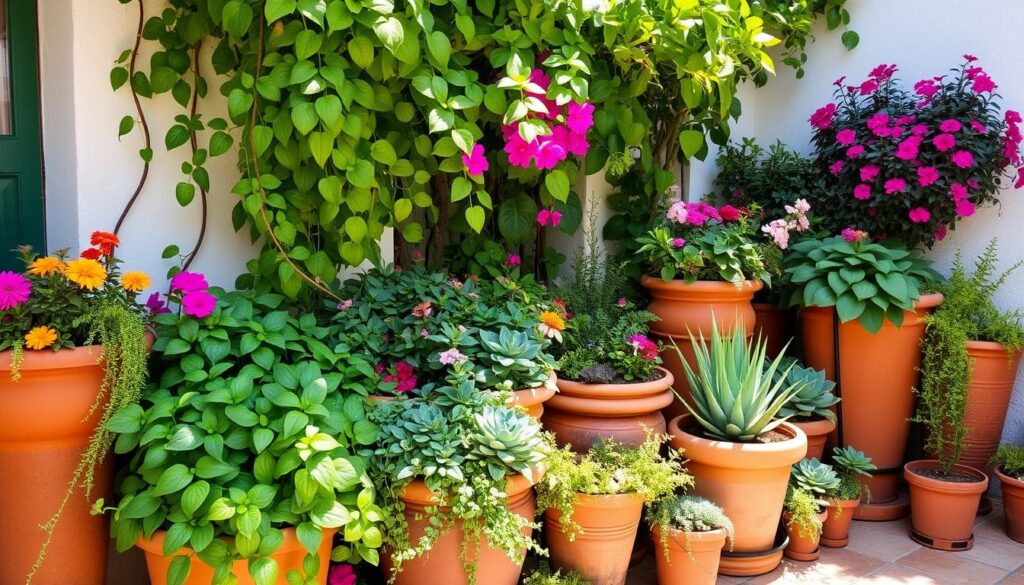
Choosing the Right Containers for Your Plants
Selecting the right container is crucial for healthy plants. Materials like ceramic, fabric, and self-watering systems each have their benefits. Ceramic pots are durable and stylish, while fabric containers promote root health. Self-watering systems are perfect for busy gardeners, ensuring your plants stay hydrated.
For dwarf fruit trees, opt for containers with at least 18″ depth. This provides enough room for roots to grow and thrive. Mobile plant caddies are another great option, allowing you to move your plants to track sunlight throughout the day.
Mixing Flowers and Herbs in Containers
Combining flowers and herbs in one container creates a functional and beautiful display. Try pairing strawberries with violas for an edible arrangement that’s both tasty and eye-catching. Mint and edible flowers like nasturtiums are perfect for a cocktail garden, adding flavor and flair to your drinks.
Overwintering perennial plants in containers requires some planning. Move them to a sheltered area or indoors to protect them from frost. With the right care, your container garden can thrive year-round, bringing life and color to your space.
Designing a Cottage Garden for a Charming Look
A cottage garden brings a touch of timeless charm to any outdoor space. This style is all about creating a relaxed, whimsical atmosphere that feels both inviting and nostalgic. By blending natural beauty with thoughtful design, you can achieve a picturesque retreat that’s perfect for relaxing or entertaining.
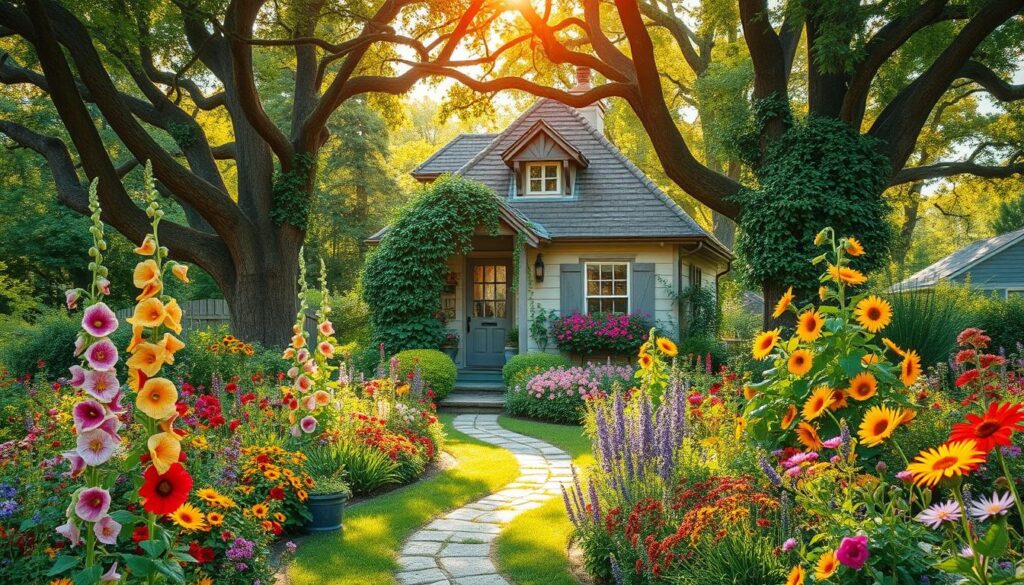
Incorporating Vintage Elements
Adding vintage touches is key to achieving the cottage look. Repurpose old items like ladder trellises or bathtub planters to create unique focal points. These elements not only add character but also make your space feel lived-in and cozy.
For pathways, consider using crushed oyster shells or gravel. These materials enhance the rustic charm while providing a practical surface. Pair them with fragrant plants like sweet pea and phlox to create a sensory experience as you stroll through your garden.
Choosing Plants for a Cottage-Style Garden
Selecting the right plants is essential for a cottage style. Old-fashioned roses and foxgloves are classic choices that add height and color. Self-seeding varieties like cosmos and poppies bring a natural, carefree vibe.
Layering heights is another important aspect. Start with edge bulbs, add mid-height flowers, and finish with climbing roses or clematis. This creates depth and visual interest, making your garden feel lush and full.
By combining these elements, you can create a cottage garden that’s both charming and functional. Whether you’re a beginner or an experienced gardener, this design offers endless possibilities for creating a space you’ll love.
Zen Garden Ideas for a Peaceful Outdoor Space
A Zen garden offers a serene escape from the chaos of daily life. This minimalist design focuses on simplicity, using natural elements to create a calming space. Whether you have a small corner or a larger area, a Zen-inspired retreat can bring tranquility to your home.
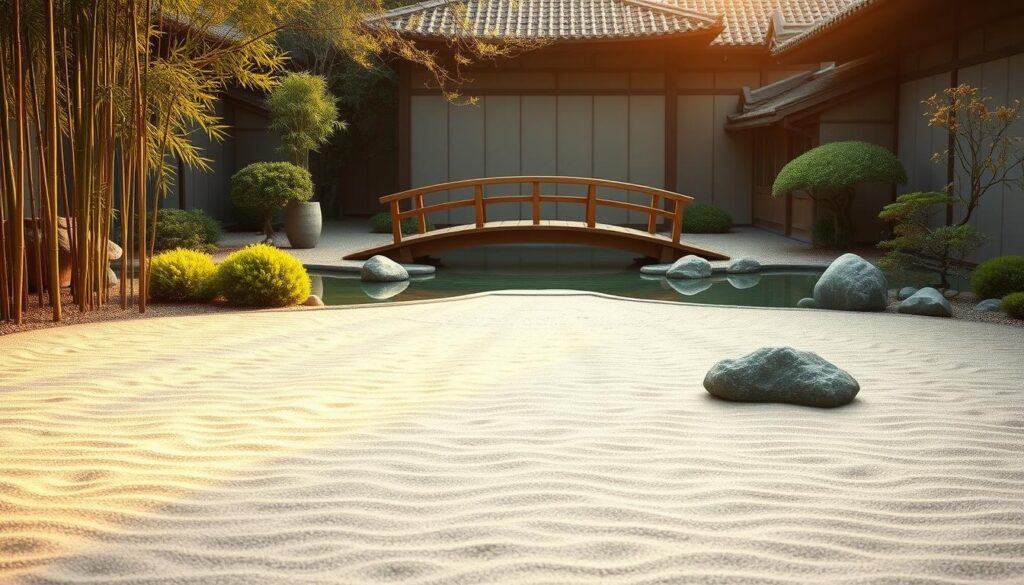
Using Rocks and Sand for a Minimalist Design
Rocks and sand are the foundation of a Zen garden. Raking patterns in the sand can be a meditative practice, helping you find peace and focus. Local stones add authentic textures and blend seamlessly with the natural surroundings.
Moss cultivation between stepping stones softens the look and adds a touch of greenery. Night lighting strategies, like subtle LED lights, enhance the garden’s beauty during moonlit evenings. These elements work together to create a harmonious and balanced space.
Incorporating Water Features for Serenity
Water features add a soothing element to your Zen retreat. A bamboo water spout is a classic choice, offering gentle sounds that promote relaxation. Different flow rates can be engineered to create varying auditory experiences, enhancing the meditative atmosphere.
Sound-masking waterfalls are another excellent option, especially in urban settings. They reduce noise pollution while adding a tranquil vibe. As one enthusiast noted,
“The sound of flowing water is the perfect way to unwind after a busy day.”
By combining these ideas, you can create a Zen garden that’s both beautiful and functional. Whether you’re seeking a quiet place to meditate or a peaceful spot to relax, this design offers a perfect escape.
Tropical Garden Ideas for a Lush, Exotic Feel
Bring the exotic beauty of the tropics to your backyard with thoughtful design. A tropical garden is all about vibrant colors, dramatic foliage, and a dense, layered look. Whether you live in a warm or cooler climate, these ideas will help you create a lush retreat that feels like a vacation destination.
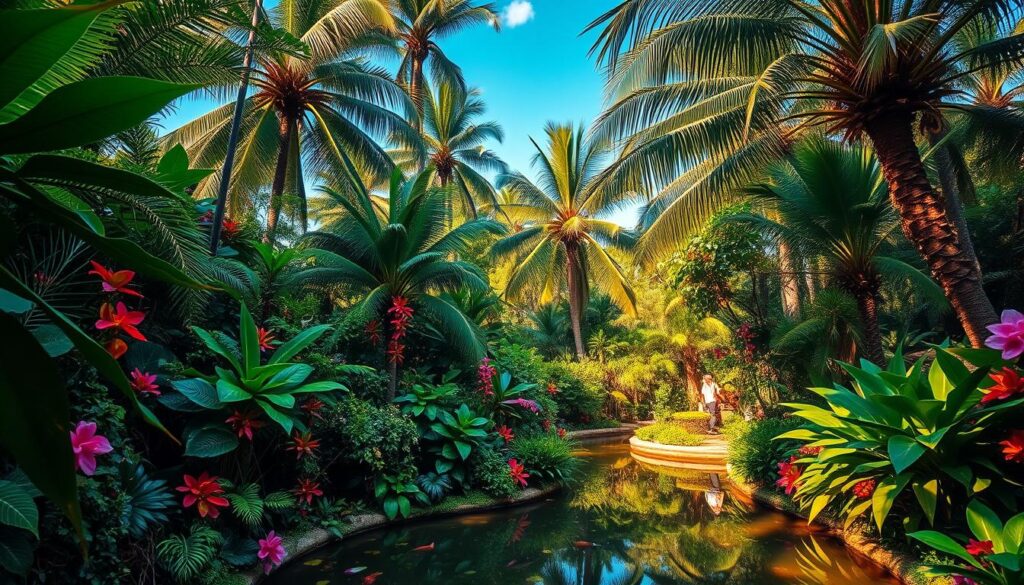
Selecting Tropical Plants for Your Climate
Choosing the right plants is essential for a thriving tropical space. In colder zones, consider using banana plants as annuals or opt for cold-hardy alternatives like windmill palms. These options bring the tropical vibe without the risk of frost damage.
For a more permanent solution, create microclimates with water features or sheltered areas. This helps tender perennials survive winter. Overwintering strategies, like moving potted plants indoors, can also protect your tropical favorites.
Creating a Dense, Layered Look
A dense, layered look is key to achieving a tropical feel. Start with dramatic foliage plants like elephant ears or bird of paradise. These bold leaves add texture and height, creating a lush canopy.
Incorporate hot hues like reds, oranges, and yellows to evoke the warmth of the tropics. Use color psychology to enhance the mood of your space. Pair these with water features or stone elements for a balanced, serene retreat.
| Feature | Recommendation | Benefits |
|---|---|---|
| Plants | Banana plants, windmill palms | Add tropical vibe, cold-hardy options |
| Microclimates | Water features, sheltered areas | Protect tender perennials, extend growing season |
| Foliage | Elephant ears, bird of paradise | Add texture and height, create lush canopy |
| Color | Reds, oranges, yellows | Evoke warmth, enhance mood |
By combining these ideas, you can transform your outdoor space into a tropical paradise. Whether you’re looking for a serene retreat or a vibrant escape, these tips will help you achieve the perfect design.
Mediterranean Garden Ideas for a Warm, Dry Climate
Embrace the essence of the Mediterranean with a design that thrives in dry climates. This style combines rustic charm with practical solutions, creating a space that’s both beautiful and sustainable. Whether you’re working with a small patio or a large yard, these ideas will help you achieve a sun-soaked retreat.
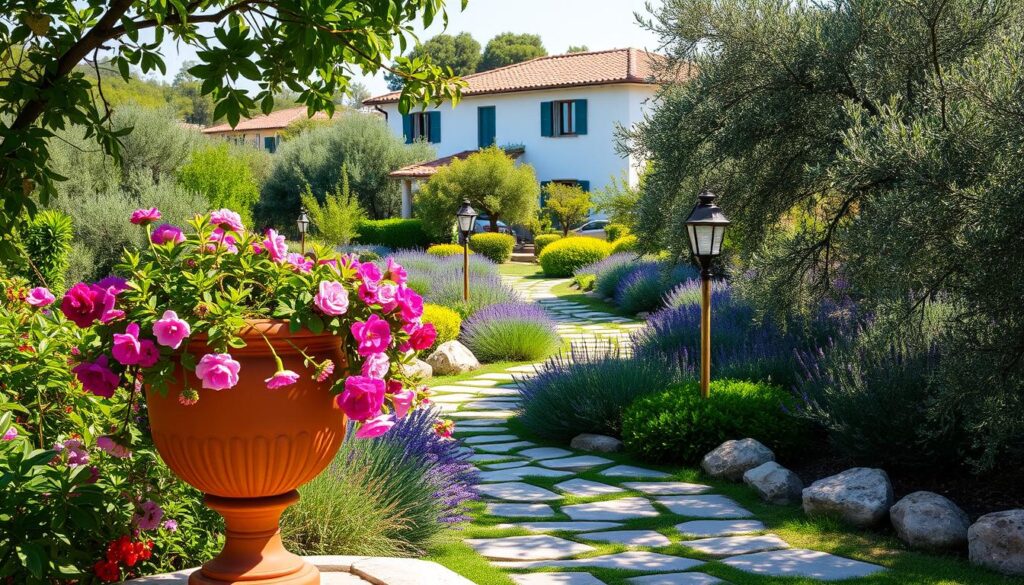
Using Drought-Tolerant Plants
Drought-tolerant plants are the backbone of a Mediterranean-inspired space. Lavender, for example, is a classic choice that thrives in various USDA zones. Its fragrant blooms add color and attract pollinators, making it a versatile addition to your garden.
Other great options include rosemary, sage, and olive trees. These plants require minimal water and maintenance, making them ideal for warm, dry regions. For container growth, consider pruning olive trees to keep them compact and manageable.
Incorporating Terracotta and Stone Elements
Terracotta pots and stone pathways are hallmarks of Mediterranean design. Their natural textures and earthy tones blend seamlessly with the surroundings, creating a cohesive look. Gravel mulch is another practical choice, helping retain moisture and reduce water usage.
For a functional yet stylish touch, add an outdoor kitchen with herb drying racks. Pair this with a pergola draped in grape vine canopies for shade and a touch of rustic elegance. These elements not only enhance the style but also make your space more enjoyable.
By combining drought-tolerant plants with terracotta and stone accents, you can create a Mediterranean-inspired retreat that’s both beautiful and practical. Whether you’re relaxing or entertaining, this design will transport you to a sun-drenched paradise.
Conclusion: Elevate Your Yard with These Designer Garden Ideas
Your outdoor area can become a personal sanctuary with the right approach. By utilizing vertical space and incorporating native plants, you can create a sustainable and beautiful retreat. These ideas not only enhance your yard but also support local ecosystems.
Start small with container or herb gardens to build confidence and see quick results. Share your progress and get inspired by joining Source 1’s garden submission program. It’s a great way to connect with others and gather fresh ideas.
Evaluate your space seasonally and make gradual improvements. Combining styles, like a cottage-meets-zen design, can add unique charm to your outdoor area. With patience and creativity, your garden will evolve into a place you’ll love.

